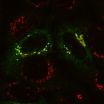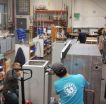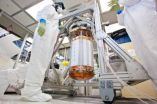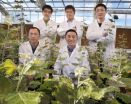(Press-News.org) In a paper published this week in the journal Physical Review Letters, MIT researchers propose an experiment that may close the last major loophole of Bell's inequality — a 50-year-old theorem that, if violated by experiments, would mean that our universe is based not on the textbook laws of classical physics, but on the less-tangible probabilities of quantum mechanics.
Such a quantum view would allow for seemingly counterintuitive phenomena such as entanglement, in which the measurement of one particle instantly affects another, even if those entangled particles are at opposite ends of the universe. Among other things, entanglement — a quantum feature Albert Einstein skeptically referred to as "spooky action at a distance"— seems to suggest that entangled particles can affect each other instantly, faster than the speed of light.
In 1964, physicist John Bell took on this seeming disparity between classical physics and quantum mechanics, stating that if the universe is based on classical physics, the measurement of one entangled particle should not affect the measurement of the other — a theory, known as locality, in which there is a limit to how correlated two particles can be. Bell devised a mathematical formula for locality, and presented scenarios that violated this formula, instead following predictions of quantum mechanics.
Since then, physicists have tested Bell's theorem by measuring the properties of entangled quantum particles in the laboratory. Essentially all of these experiments have shown that such particles are correlated more strongly than would be expected under the laws of classical physics — findings that support quantum mechanics.
However, scientists have also identified several major loopholes in Bell's theorem. These suggest that while the outcomes of such experiments may appear to support the predictions of quantum mechanics, they may actually reflect unknown "hidden variables" that give the illusion of a quantum outcome, but can still be explained in classical terms.
Though two major loopholes have since been closed, a third remains; physicists refer to it as "setting independence," or more provocatively, "free will." This loophole proposes that a particle detector's settings may "conspire" with events in the shared causal past of the detectors themselves to determine which properties of the particle to measure — a scenario that, however far-fetched, implies that a physicist running the experiment does not have complete free will in choosing each detector's setting. Such a scenario would result in biased measurements, suggesting that two particles are correlated more than they actually are, and giving more weight to quantum mechanics than classical physics.
"It sounds creepy, but people realized that's a logical possibility that hasn't been closed yet," says MIT's David Kaiser, the Germeshausen Professor of the History of Science and senior lecturer in the Department of Physics. "Before we make the leap to say the equations of quantum theory tell us the world is inescapably crazy and bizarre, have we closed every conceivable logical loophole, even if they may not seem plausible in the world we know today?"
Now Kaiser, along with MIT postdoc Andrew Friedman and Jason Gallicchio of the University of Chicago, have proposed an experiment to close this third loophole by determining a particle detector's settings using some of the oldest light in the universe: distant quasars, or galactic nuclei, which formed billions of years ago.
The idea, essentially, is that if two quasars on opposite sides of the sky are sufficiently distant from each other, they would have been out of causal contact since the Big Bang some 14 billion years ago, with no possible means of any third party communicating with both of them since the beginning of the universe — an ideal scenario for determining each particle detector's settings.
As Kaiser explains it, an experiment would go something like this: A laboratory setup would consist of a particle generator, such as a radioactive atom that spits out pairs of entangled particles. One detector measures a property of particle A, while another detector does the same for particle B. A split second after the particles are generated, but just before the detectors are set, scientists would use telescopic observations of distant quasars to determine which properties each detector will measure of a respective particle. In other words, quasar A determines the settings to detect particle A, and quasar B sets the detector for particle B.
The researchers reason that since each detector's setting is determined by sources that have had no communication or shared history since the beginning of the universe, it would be virtually impossible for these detectors to "conspire" with anything in their shared past to give a biased measurement; the experimental setup could therefore close the "free will" loophole. If, after multiple measurements with this experimental setup, scientists found that the measurements of the particles were correlated more than predicted by the laws of classical physics, Kaiser says, then the universe as we see it must be based instead on quantum mechanics.
"I think it's fair to say this [loophole] is the final frontier, logically speaking, that stands between this enormously impressive accumulated experimental evidence and the interpretation of that evidence saying the world is governed by quantum mechanics," Kaiser says.
Now that the researchers have put forth an experimental approach, they hope that others will perform actual experiments, using observations of distant quasars.
"At first, we didn't know if our setup would require constellations of futuristic space satellites, or 1,000-meter telescopes on the dark side of the moon," Friedman says. "So we were naturally delighted when we discovered, much to our surprise, that our experiment was both feasible in the real world with present technology, and interesting enough to our experimentalist collaborators who actually want to make it happen in the next few years."
Adds Kaiser, "We've said, 'Let's go for broke — let's use the history of the cosmos since the Big Bang, darn it.' And it is very exciting that it's actually feasible."
INFORMATION:
This research was funded by the National Science Foundation.
Written by Jennifer Chu, MIT News Office
Researchers say distant quasars could close a loophole in quantum mechanics
MIT researchers propose using distant quasars to test Bell's theorem
2014-02-20
ELSE PRESS RELEASES FROM THIS DATE:
Crop species may be more vulnerable to climate change than we thought
2014-02-20
A new study by a Wits University scientist has overturned a long-standing hypothesis about plant speciation (the formation of new and distinct species in the course of evolution), suggesting that agricultural crops could be more vulnerable to climate change than was previously thought.
Unlike humans and most other animals, plants can tolerate multiple copies of their genes – in fact some plants, called polyploids, can have more than 50 duplicates of their genomes in every cell. Scientists used to think that these extra genomes helped polyploids survive in new and extreme ...
Surprising culprit found in cell recycling defect
2014-02-20
To remain healthy, the body's cells must properly manage their waste recycling centers. Problems with these compartments, known as lysosomes, lead to a number of debilitating and sometimes lethal conditions.
Reporting in the Proceedings of the National Academy of Sciences (PNAS), researchers at Washington University School of Medicine in St. Louis have identified an unusual cause of the lysosomal storage disorder called mucolipidosis III, at least in a subset of patients. This rare disorder causes skeletal and heart abnormalities and can result in a shortened lifespan. ...
MD Anderson researcher uncovers some of the ancient mysteries of leprosy
2014-02-20
Research at The University of Texas MD Anderson Cancer Center is finally unearthing some of the ancient mysteries behind leprosy, also known as Hansen's disease, which has plagued mankind throughout history. The new research findings appear in the current edition of journal PLOS Neglected Tropical Diseases. According to this new hypothesis, the disease might be the oldest human-specific infection, with roots that likely stem back millions of years.
There are hundreds of thousands of new cases of leprosy worldwide each year, but the disease is rare in the United States, ...
Sustainable manufacturing system to better consider the human component
2014-02-20
CORVALLIS, Ore. – Engineers at Oregon State University have developed a new approach toward "sustainable manufacturing" that begins on the factory floor and tries to encompass the totality of manufacturing issues – including economic, environmental, and social impacts.
This approach, they say, builds on previous approaches that considered various facets of sustainability in a more individual manner. Past methods often worked backward from a finished product and rarely incorporated the complexity of human social concerns.
The findings have been published in the Journal ...
New calibration confirms LUX dark matter results
2014-02-20
PROVIDENCE, R.I. [Brown University] — A new high-accuracy calibration of the LUX (Large Underground Xenon) dark matter detector demonstrates the experiment's sensitivity to ultra-low energy events. The new analysis strongly confirms the result that low-mass dark matter particles were a no-show during the detector's initial run, which concluded last summer.
The first dark matter search results from LUX detector were announced last October. The detector proved to be exquisitely sensitive, but found no evidence of the dark matter particles during its first 90-day run, ruling ...
Better broccoli, enhanced anti-cancer benefits with longer shelf life
2014-02-20
URBANA, Ill. – While researching methods to increase the already well-recognized anti-cancer properties of broccoli, researchers at the University of Illinois also found a way to prolong the vegetable's shelf life.
And, according to the recently published study, the method is a natural and inexpensive way to produce broccoli that has even more health benefits and won't spoil so quickly on your refrigerator shelf.
Jack Juvik, a U of I crop sciences researcher, explained that the combined application of two compounds, both are natural products extracted from plants, increased ...
Smaller meals more times per day may curb obesity in cats
2014-02-20
URBANA, Ill. – Just as with people, feline obesity is most often linked to excessive food intake or not enough physical activity. Attempts to cut back on calories alone often result in failed weight loss or weight regain in both people and their pets.
So how do you encourage your cat to get more exercise?
Researchers from the University of Illinois interested in finding a method to maintain healthy body weight in cats, looked at a previously suggested claim that increased meal frequency could help to increase overall physical activity.
The idea is to feed cats the ...
Color vision problems become more common with age, reports Optometry and Vision Science
2014-02-20
Philadelphia, Pa. (February 20, 2014) - Abnormal color vision increases significantly with aging—affecting one-half or more of people in the oldest age groups, reports a study in Optometry and Vision Science, official journal of the American Academy of Optometry. The journal is published by Lippincott Williams & Wilkins, a part of Wolters Kluwer Health.
While few people younger than 70 have problems with color vision, the rate increases rapidly through later decades of life, according to the new research by Marilyn E. Schneck, PhD, and colleagues of The Smith-Kettlewell ...
Roots to shoots: Hormone transport in plants deciphered
2014-02-20
Plant growth is orchestrated by a spectrum of signals from hormones within a plant. A major group of plant hormones called cytokinins originate in the roots of plants, and their journey to growth areas on the stem and in leaves stimulates plant development. Though these phytohormones have been identified in the past, the molecular mechanism responsible for their transportation within plants was previously poorly understood.
Now, a new study from a research team led by biochemist Chang-Jun Liu at the U.S. Department of Energy's (DOE) Brookhaven National Laboratory identifies ...
New research shows the way a room is lit can affect the way you make decisions
2014-02-20
The next time you want to turn down the emotional intensity before making an important decision, you may want to dim the lights first.
A new study from the University of Toronto Scarborough shows that human emotion, whether positive or negative, is felt more intensely under bright light. Alison Jing Xu, assistant professor of management at UTSC and the Rotman School of Management, along with Aparna Labroo of Northwestern University, conducted a series of studies to examine the unusual paradox of lighting and human emotion.
"Other evidence shows that on sunny days people ...
LAST 30 PRESS RELEASES:
Numbers in our sights affect how we perceive space
SIMJ announces global collaborative book project in commemoration of its 75th anniversary
Air pollution exposure and birth weight
Obstructive sleep apnea risk and mental health conditions among older adults
How talking slows eye movements behind the wheel
The Ceramic Society of Japan’s Oxoate Ceramics Research Association launches new international book project
Heart-brain connection: international study reveals the role of the vagus nerve in keeping the heart young
Researchers identify Rb1 as a predictive biomarker for a new therapeutic strategy in some breast cancers
Survey reveals ethical gaps slowing AI adoption in pediatric surgery
Stimulant ADHD medications work differently than thought
AI overestimates how smart people are, according to HSE economists
HSE researchers create genome-wide map of quadruplexes
Scientists boost cell "powerhouses" to burn more calories
Automatic label checking: The missing step in making reliable medical AI
Low daily alcohol intake linked to 50% heightened mouth cancer risk in India
American Meteorological Society announces Rick Spinrad as 2026 President-Elect
Biomass-based carbon capture spotlighted in newly released global climate webinar recording
Illuminating invisible nano pollutants: advanced bioimaging tracks the full journey of emerging nanoscale contaminants in living systems
How does age affect recovery from spinal cord injury?
Novel AI tool offers prognosis for patients with head and neck cancer
Fathers’ microplastic exposure tied to their children’s metabolic problems
Research validates laboratory model for studying high-grade serous ovarian cancer
SIR 2026 delivers transformative breakthroughs in minimally invasive medicine to improve patient care
Stem Cell Reports most downloaded papers of 2025 highlight the breadth and impact of stem cell research
Oxford-led study estimates NHS spends around 3% of its primary and secondary care budget on the health impacts of heat and cold in England
A researcher’s long quest leads to a smart composite breakthrough
Urban wild bees act as “microbial sensors” of city health.
New study finds where you live affects recovery after a hip fracture
Forecasting the impact of fully automated vehicle adoption on US road traffic injuries
Alcohol-related hospitalizations from 2016 to 2022
[Press-News.org] Researchers say distant quasars could close a loophole in quantum mechanicsMIT researchers propose using distant quasars to test Bell's theorem




